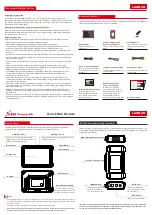
7
2104766-13-08/20 (Translation of the original operating instructions)
Operating instructions
Non-Contact Safety System CES-AZ-AES-…
EN
3. Description of the safety function
Devices from this series feature the following safety functions:
The following applies in combination with read heads without guard locking (CES read heads) and read heads with guard
locking for process protection (CEM read heads):
Monitoring of the position of a guard
(interlocking device according to EN ISO 14119)
Ì
Safety function:
-The safety contacts are switched off when the guard is open (see chapter
).
Ì
Safety characteristics: category, Performance Level, PFH
D
(see chapter
The following applies in combination with read heads with guard locking (CET-AX):
Monitoring of guard locking and the position of the guard
(interlocking device with guard locking according to EN ISO 14119)
Ì
):
-The safety contacts are switched off when guard locking is released (monitoring of the locking element).
-The safety contacts are switched off when the guard is open.
-Guard locking can be activated only when the actuator is located in the switch head (prevention of inadvertent locking
position (faulty closure protection)).
Ì
Safety characteristics: category, Performance Level, PFH
D
(see chapter
Control of guard locking
Ì
If the device is used as guard locking for personnel protection, the control of the guard locking must be regarded as a
safety function.
Ì
The device does not feature a safety characteristic for the control of the guard locking, because the guard locking so-
lenoid is completely disconnected from outside the device (no control function within the device). It therefore does not
contribute to the failure probability.
Ì
The safety level for the control of guard locking is determined exclusively by the external control (e.g. PFH
D
ext.
for the
standstill monitor).
PFH
D
ext.
Guardlocking Device
(e.g. standstill
monitor)
(locking mean)








































